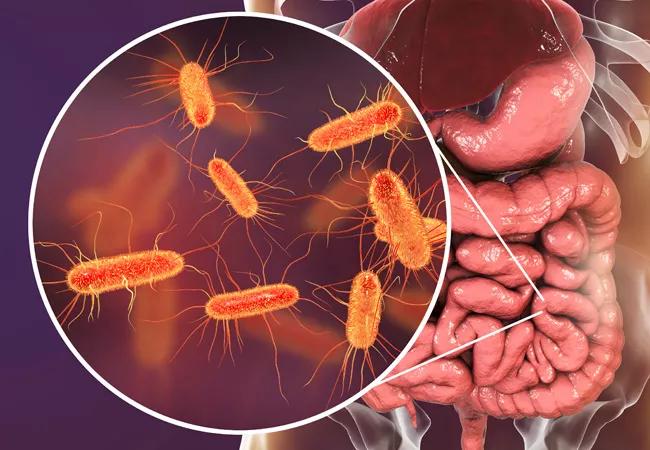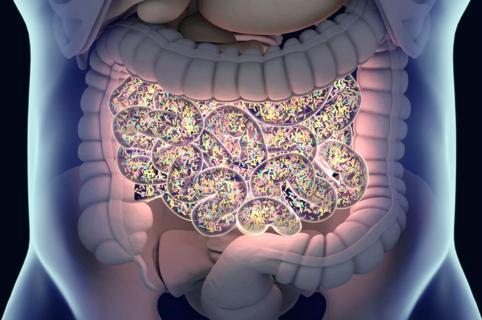Phenylacetylglutamine acts via adrenergic receptors and is linked with cardiac events

A Cleveland Clinic-led investigation published in Cell has identified a new gut microbial metabolite that acts via adrenergic receptors and is linked with cardiovascular disease and major adverse cardiovascular events, including myocardial infarction (MI), stroke and death.
Advertisement
Cleveland Clinic is a non-profit academic medical center. Advertising on our site helps support our mission. We do not endorse non-Cleveland Clinic products or services. Policy
The findings suggest that some of the benefits of beta-blockers may be related to prevention of activity related to the newly identified metabolite, known as phenylacetylglutamine (PAG).
The researchers, led by Stanley Hazen, MD, PhD, found that when the amino acid phenylalanine — found in animal- and plant-based foods such as meat, beans and soy — is broken down by microbes in the gut, PAG is one of the plasma byproducts that ultimately result.
This finding came from a research approach known as untargeted metabolomics performed on plasma from an initial discovery-based study in a cohort of 1,162 patients undergoing elective diagnostic cardiac evaluation. Candidate molecules whose levels predicted future development of cardiovascular events were identified. Then, after structural identification and after a more-specific assay was established, the relationship between PAG and incident cardiac risks was confirmed in an independent validation cohort of 4,000 stable patients. The researchers also found that PAG levels in blood were elevated among subjects with type 2 diabetes.
“These findings are consistent with animal model and microbe transplantation studies that suggest this gut microbe-derived metabolite may play an important role in driving cardiovascular disease,” says Dr. Hazen, who serves as Chair of Cardiovascular and Metabolic Sciences in Cleveland Clinic’s Lerner Research Institute and Co-Section Head of Preventive Cardiology and Rehabilitation in its Miller Family Heart, Vascular & Thoracic Institute.
Advertisement
The researchers found that PAG contributes to cardiovascular risk in at least two ways.
After analyzing whole blood cells, platelet-rich plasma and isolated platelets from patient samples to understand how PAG affects cell processes, the researchers used mouse models of arterial injury to explore how these cellular changes manifest. They found that PAG enhanced platelet reactivity and thrombosis potential.
They also discovered that PAG interacts with G-protein coupled receptors (GPCRs), including three adrenergic receptors present on platelets: alpha-2A, alpha-2B and beta-2. They then showed with genetic and pharmacological studies that PAG exposure to GPCRs on platelets in general — and these three adrenergic receptors specifically — leads to a cascade of cellular events that contribute to disease.
“Part of the reason we were so interested in our discovery of PAG is because it binds to the same receptors as beta-blockers, which are associated with reduced risk for cardiovascular mortality and the treatment of various cardiovascular diseases,” explains Dr. Hazen, who also directs the Cleveland Clinic Center for Microbiome and Human Health.
Administering beta-blockers in a mouse model of elevated PAG was shown to reverse adverse cardiovascular events driven by PAG; additional genetic studies showed that adrenergic receptors were critical to promoting adverse cardiovascular phenotypes caused by elevation of PAG. The team also found that using gene editing technology on gut microbes could alter PAG generation and significantly reduced thrombotic activity in animal models.
Advertisement
“We believe our findings suggest that some of the benefits of beta-blockers may be attributed to preventing the activity of the gut microbe-generated metabolite PAG,” notes Dr. Hazen. “Despite the extensive use and study of beta-blockers, this is the first time, to our knowledge, that this mechanism has been suggested as an explanation for some of their benefits. PAG appears to serve as an allosteric modulator of adrenergic receptors.”
Notably, the investigation found that the effect of PAG on cardiovascular risk was independent of, and additive to, the effects of TMAO (trimethylamine N-oxide). In 2011, Dr. Hazen’s research team made the seminal discovery that TMAO — a metabolite produced when gut microbes break down choline, a nutrient that’s abundant in animal products such as meat and egg yolk — enhances platelet activity and increases risk for various forms of cardiometabolic disease.
Recently, the team designed a potential new class of drugs that may reduce cardiovascular risk by targeting the gut microbe pathway that produces TMAO. It is the most potent therapy to date for “drugging” the microbiome to alter disease processes and represents a novel therapeutic strategy for preventing or treating cardiovascular disease — use of a drug that essentially remains outside of the host, targeting the bacterial pathway in the gut.
“These studies by Dr. Hazen are revolutionizing how we think about food and disease,” says Leslie Cho, MD, who serves as Co-Section Head of Preventive Cardiology and Rehabilitation at Cleveland Clinic along with Dr. Hazen. “We have always known that we are what we eat, but now we are getting further proof. We are only beginning to understand the great impact of food and the gut microbiome on our health. These are exciting times in medicine.”
Advertisement
The work reported in Cell was supported by the National Heart, Lung, and Blood Institute as well as the Leducq Foundation.
Dr. Hazen reports being named as co-inventor on pending and issued patents held by Cleveland Clinic relating to cardiovascular diagnostics and therapeutics, being a paid consultant to P&G, having received research funds from P&G and Roche Diagnostics, and being eligible to receive royalty payments for inventions or discoveries related to cardiovascular diagnostics or therapeutics from Cleveland HeartLab, Quest Diagnostics and P&G.
Advertisement
Advertisement

First full characterization of kidney microbiome unlocks potential to prevent kidney stones

Researchers identify potential path to retaining chemo sensitivity

Large-scale joint study links elevated TMAO blood levels and chronic kidney disease risk over time

Investigators are developing a deep learning model to predict health outcomes in ICUs.

Preclinical work promises large-scale data with minimal bias to inform development of clinical tests

Cleveland Clinic researchers pursue answers on basic science and clinical fronts

Study suggests sex-specific pathways show potential for sex-specific therapeutic approaches

Cleveland Clinic launches Quantum Innovation Catalyzer Program to help start-up companies access advanced research technology